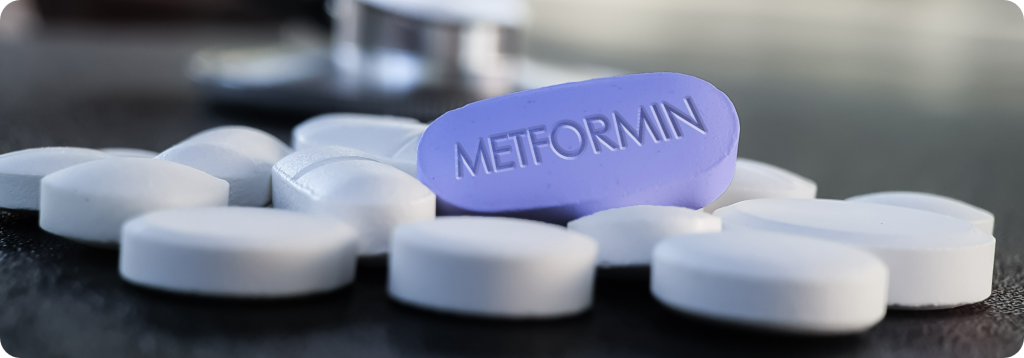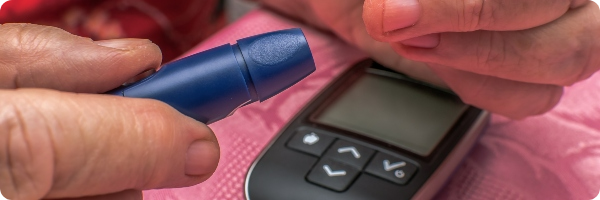What is type 2 diabetes?
Type 2 diabetes is the commonest form of diabetes, and one of the world’s most common long-term health conditions. The number of people in the UK expected to have the condition is over 4.8 million – which is predicted to rise to 5.3 million by 2025.
If you’re diagnosed with type 2 diabetes, this means that your fat, liver, and muscle cells don’t respond to the hormone insulin correctly. It’s a condition that causes the level of sugar (glucose) in the blood to be too high. Although type 2 diabetes is often linked to being inactive or overweight, this isn’t the case for everyone who goes on to develop the condition. Family history and genetic makeup can also play a role in receiving the diagnosis.

What’s the difference between type 1 and type 2 diabetes?
Although the symptoms of type 1 and type 2 diabetes are similar, the underlying causes and treatment options differ. Type 1 diabetes, being the less common of the two, is a genetic condition that can develop earlier in life, whereas type 2 diabetes can develop gradually over time.
If someone is diagnosed with type 1 diabetes, this means that their body’s immune system attacks the cells responsible for producing insulin – a hormone that helps blood sugar enter the body’s cells, which is then used for energy. A type 2 diagnosis, on the other hand, would mean that their body doesn’t produce enough insulin, or that the cells are unresponsive to insulin – which is known as ‘insulin resistance’.
A type 2 diagnosis can sometimes be avoided or put into remission by making lifestyle changes – for example, eating a balanced diet and staying active to maintain a healthy weight.
What are the symptoms of type 2 diabetes?
Some people can have type 2 diabetes without knowing it, as some symptoms may not necessarily make you feel unwell. If you do have any of the following symptoms, or if you’re worried that you may have a higher risk of developing type 2 diabetes, book a doctor’s appointment to see your GP.
Common symptoms of type 2 diabetes
- Feeling very thirsty
- Feeling very tired
- Peeing more than normal, particularly throughout the night
- Blurred vision
- Cuts and grazes that won’t heal
- Recurring thrush
- Losing weight without trying

Less common symptoms of type 2 diabetes
- Stomach issues and nausea
- Dry mouth
- Dark-coloured skin on the neck (acanthosis nigricans)
- Recurring urinary tract infections and skin complications
- Feeling dizzy
- Feeling irritable
- Erectile dysfunction in men
- Painful limbs as a result of nerve damage (diabetic neuropathy)
- Itchy skin
Symptoms of type 2 diabetes in children
Type 2 diabetes can present in children and young adults. As the condition can develop so gradually, the symptoms may go unnoticed. Therefore, type 2 diabetes may be diagnosed during a routine check-up.
If your child has type 2 diabetes, they may display the following symptoms:
- Increased thirst and hunger
- Frequent urination
- Fatigue
- Blurred vision
- Frequent infections
- Unintentional weight loss – this symptom is less common, and occurs more in children with type 1 diabetes
- Darkened areas of skin – generally around the neck or in the armpits and groin
Learning that your child has type 2 diabetes can bring up all kinds of emotions, but a children’s (paediatric) diabetes team can help make managing the condition easier – both for you and your child. They can advise on how to manage diabetes, how to test blood glucose levels, and how you can safely adjust your child’s diet to align with their needs.
Preventing type 2 diabetes
There are ways to either prevent or delay type 2 diabetes. Even if you have a higher risk of developing the condition, losing a small amount of weight and being more physically active, as well as consuming a healthy diet, can help decrease the chance of a diagnosis.
Treating type 2 diabetes
After you’ve received a type 2 diabetes diagnosis, there are things you can do to help manage and potentially put the condition into remission (when caught early on), this includes the following:
Diet
If you have type 2 diabetes, adjusting your diet by doing the following can help you to maintain a healthy weight:
- Eating regular, balanced meals that include plenty of healthy fats and lean protein
- Cooking with healthier oils, such as extra virgin olive oil or avocado oil.
- Avoiding foods that the body treats as sugar, such as refined carbohydrates (including white pasta, white bread, white rice, sweets and starchy bread).
- Consuming high-fibre foods, including fruits, non-starchy vegetables, and wholegrains. It’s important to note that insoluble fibre may not be suitable for those with Inflammatory Bowel Diseases (IBD), or with ileostomy, colostomy or stoma.
- Eating fewer refined grains, sweets, and starchy vegetables.
- Cooking with cinnamon might also lower blood sugar by increasing insulin sensitivity, which helps to fight type 2 diabetes.

Making these changes might feel overwhelming, but take it one step at a time and go at your own pace – this is about long term sustainable change, not a quick fix. Experiment with new ideas, with the support of your doctor or a nutritional therapist, and find out what works for you.
Exercise
Physical activity is another way to help maintain a healthy weight, and it can also help to regulate blood sugar levels – which is beneficial for someone with type 2 diabetes. To make sure that your exercise regime is safe for you, make sure to have a chat with your doctor beforehand.
A mixture of aerobic exercise – such as walking, biking, and swimming – and resistance training – which helps to enhance balance and strength – can help to keep your body healthy. Breaking up long periods of inactivity is also beneficial for controlling blood sugar levels. So, if you often find yourself sitting at your desk, stand up for a few minutes every so often, or go for a short walk. For more advice on how to improve your fitness, our article can help.
Medication
Metformin
Some people may need medicine to keep their type 2 diabetes under control. It’s necessary to combine medication with a healthy diet and exercise, which should help to stabilise your blood sugar levels.
There are various types of medication you can take for type 2 diabetes, so it might take time to find the medicine and dose that works best for you. Normally, you’ll be offered metformin, which helps to improve the way your body handles insulin.
However, you might be required to take additional medicines, or a different medication (such as insulin), if the following applies to you:
- The medication isn’t keeping your blood sugar levels within a healthy range
- You have heart problems
- You need to lose weight
Through joint decision-making, you can work with your GP to help find the best treatment method for your condition.

Other type 2 diabetes medications
If metformin isn’t working well on its own, you can’t take it, or you have any other health problems, there are other medications you can take either instead of, or alongside, metformin.
These include the following:
- Gliclazide, glimepiride, alogliptin, pioglitazone or linagliptin – which help to lower your blood sugar
- Empagliflozin or dapagliflozin – which help to lower your blood sugar and help your heart pump blood around your body
- Exenatide or liraglutide – which help to lower your blood sugar and lose weight
Insulin
If the medications you’re taking are no longer effective in keeping your blood sugar within a healthy range, you may be required to take insulin.
Occasionally, insulin may only need to be taken over a short period of time – such as if you’re pregnant, ill, or you need to bring your blood sugar down after receiving your diagnosis.
Insulin can be injected using an insulin pen, which helps you to take a safe dosage. Your doctor will show you how to use this.
Managing type 2 diabetes
Receiving a diagnosis of diabetes might feel overwhelming. However, there are steps you can take to help make managing the condition easier and potentially put it into remission.
Measuring blood sugar
Blood glucose monitor
If you have diabetes, it’s important that you keep a close eye on your blood sugar levels to ensure that they’re within a healthy range. The options for measuring your blood sugar will vary depending on how you treat your diabetes.
If you’re required to take insulin for your diabetes, you should already have a blood glucose monitor. This device has a lancet to prick your finger, a digital display to display the reading, and a place to insert a test strip. However, regular finger pricking is generally not needed in non-insulin controlled type 2 diabetes.
Some individuals (primarily those with type 1 diabetes) may benefit more from continuous glucose monitoring (CGM), rather than finger pricking. A CGM is made up of a sensor, which is attached to your arm or stomach, and it will sense how much glucose is in the interstitial fluid, which sits under your skin. A reader or receiver will show you your results, but you can also get your results sent to your smartphone.
Test strip
You can get test strips on prescription, but they’re also available to buy over the counter. A test strip is inserted into your blood glucose monitor, and you’ll need to apply a drop of your blood to the strip to get a blood sugar reading.

Apps for diabetes
Various applications can also make diabetes management easier. Whether you want to keep track of your calories, blood sugar, weight, or you simply want to find communities to be a part of, there’s an app for just about anything.
There are also apps, such as Evergreen Life, that allow you to take control of your health information with ease – from connecting to your GP record to booking appointments. Organisation is key for managing a diabetes diagnosis, so if you’re feeling overwhelmed, these apps can help to keep your health in check.
Practicalities
Insurance
Depending on the type of insurance concerned – whether that be life insurance, driving insurance, or travel insurance – those with a diabetes diagnosis may need to take extra care to prevent any future issues. If you’re ever unsure when making these important decisions, you can always rely on the help of an independent financial or other professional adviser.
Driving
It’s possible for individuals with a diabetes diagnosis to drive without any concerns, however, certain factors should still be considered. For example, if you’re at risk of hypoglycaemia (which is when your blood sugar gets too low), or if you display certain diabetes systems – such as eye problems (retinopathy) or nerve damage (neuropathy) – it may be harder to drive safely. If you’re ever unsure about whether you should drive, always seek advice from your doctor.
Sex
Sometimes, high blood sugar levels can affect the nerves and blood vessels in the body, which means that the ones that supply blood to your sexual organs can also be affected. This, in turn, can result in some lost feeling to your genitals, making physical and emotional arousal harder.
Although sexual dysfunction may not apply to everyone with a diabetes diagnosis, it’s important to talk through any concerns you may have. In this scenario, a relationship counsellor can help. Or, if you’re struggling to share your thoughts with your partner, you could have a chat with friends and family to help alleviate some stress.
Take away
If you take a proactive approach to a type 2 diabetes diagnosis, it’s possible to successfully manage the condition and potentially put it into remission. Having a good relationship with your GP is crucial for diabetes management, as shared decision-making is needed to help find the best treatment method for you. Beyond treatment for the condition, your GP can also advise you on how best to manage the emotional components of diabetes, such as anxiety and depression. By working together, it’s much easier to devise a post-diagnosis plan of action – which will be unique to you.
Take control of your health and wellbeing. Download the Evergreen Life app today, and own your GP medical history.
Reviewed by:
Anna Keeble – Head of Content
- American Academy of Dermatology Association (n.d.) Diabetes: 12 warning signs that appear on your skin. American Academy of Dermatology Association.
- American Diabetes Association (2021) Diabetes and Skin Complications. American Diabetes Association.
- Centers for Disease Control and Prevention (2022) Prevent Type 2 Diabetes. Centers for Disease Control and Prevention.
- Centers for Disease Control and Prevention (2022) What is Type 1 Diabetes? Centers for Disease Control and Prevention.
- Centers for Disease Control and Prevention (2021) Insulin Resistance and Diabetes. Centers for Disease Control and Prevention.
- Cleveland Clinic (2022) Diabetes and Dry Mouth. Cleveland Clinic.
- Seery C (2022) Diabetes Prevalence. Diabetes.co.uk.
- Seery C (2019) Urinary Tract Infections – UTIs. Diabetes.co.uk.
- Singh A (2022) Dizziness. Diabetes.co.uk.
- Diabetes UK (2022) Children and type 2 diabetes. Diabetes UK.
- Diabetes UK (2022) Diabetes and sexual problems – in men. Diabetes UK.
- Diabetes UK (2021) Driving and diabetes. Diabetes UK.
- Diabetes UK (2019) Insurance and diabetes. Diabetes UK.
- Diabetes UK (2020) Sex and diabetes. Diabetes UK.
- Link, R (2022) How Cinnamon Lowers Blood Sugar and Fights Diabetes. Healthline.
- Mayo Clinic (2022) Diabetic neuropathy. Mayo Clinic.
- Mayo Clinic (2021) Type 2 diabetes – Diagnosis and treatment. Mayo Clinic.
- Mayo Clinic (2022) Type 2 diabetes in children. Mayo Clinic.
- MedlinePlus (2022) Type 2 diabetes. Medline Plus.
- National Institute of Diabetes and Digestive and Kidney Diseases (2016) Preventing Type 2 Diabetes. National Institute of Diabetes and Digestive and Kidney Diseases.
- NHS UK (2022) Metformin. NHS UK.
- NHS UK (2020) Symptoms – Type 2 diabetes. NHS UK.
- NHS UK (2021) Continuous glucose monitoring (CGM) and flash. NHS UK.
- NHS UK (2020) Type 2 diabetes. NHS UK.
- NHS UK (2020) Understanding medicine – Type 2 diabetes. NHS UK.
- WebMD (2019) When diabetes causes stomach problems. WebMD.
- Wood K and Felman A (2022) How does diabetes affect mood and relationships? Medical News Today?







